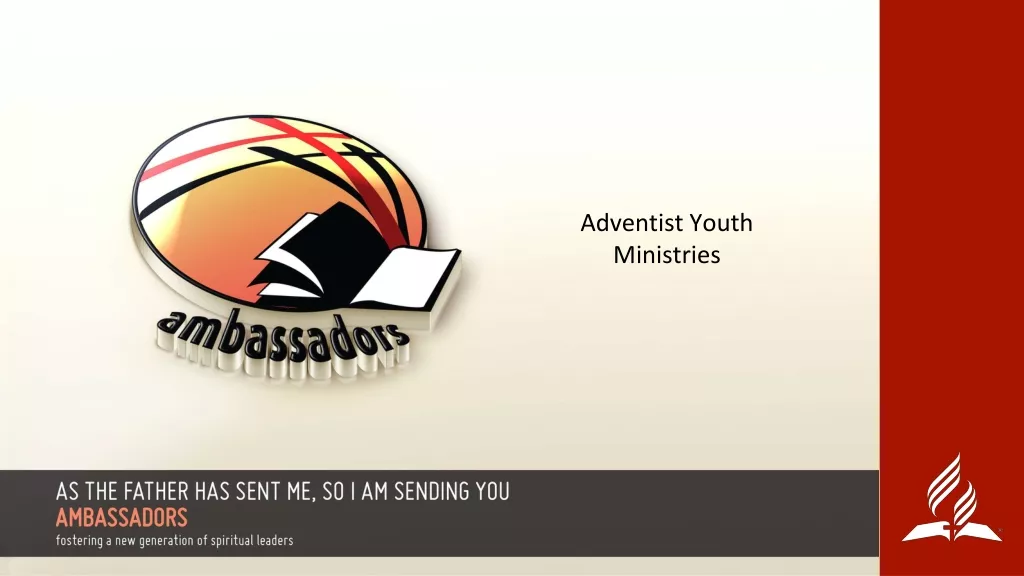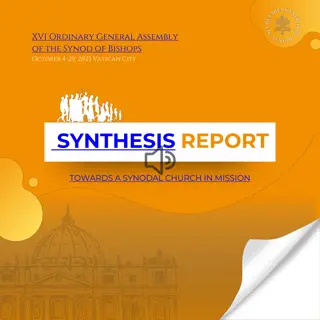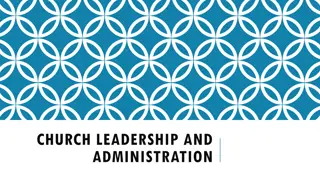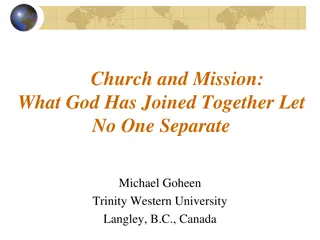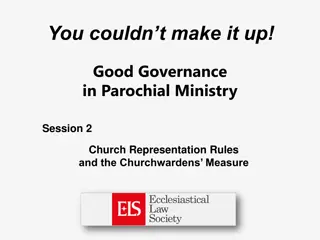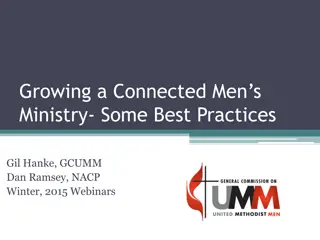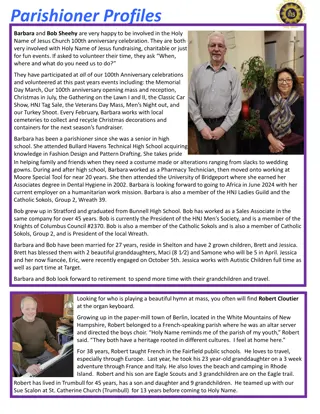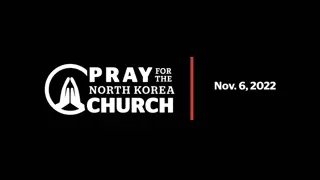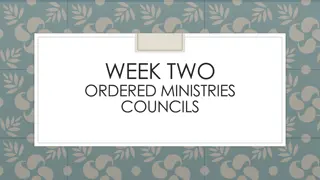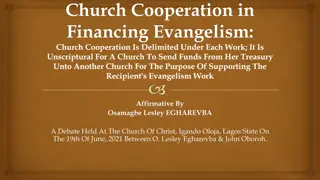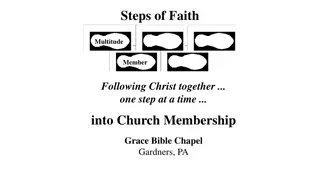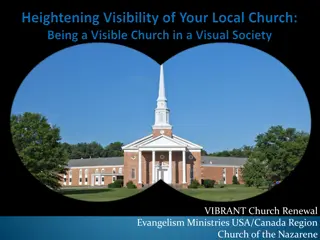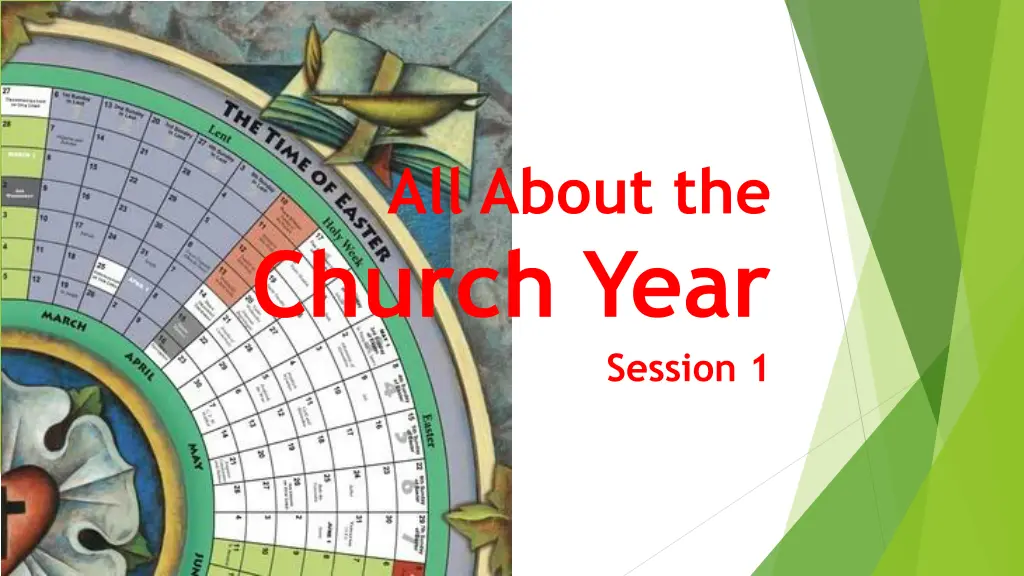
Church Year Overview and Seasons
Explore the significance of the Church Year, its formation, the Lectionary source, and how it aids believers. Learn about the different seasons, colors used, and specific observances like Advent, Epiphany, Pentecost, and Christmas.
Uploaded on | 2 Views
Download Presentation

Please find below an Image/Link to download the presentation.
The content on the website is provided AS IS for your information and personal use only. It may not be sold, licensed, or shared on other websites without obtaining consent from the author. If you encounter any issues during the download, it is possible that the publisher has removed the file from their server.
You are allowed to download the files provided on this website for personal or commercial use, subject to the condition that they are used lawfully. All files are the property of their respective owners.
The content on the website is provided AS IS for your information and personal use only. It may not be sold, licensed, or shared on other websites without obtaining consent from the author.
E N D
Presentation Transcript
All About the Church Year Session 1
What do you know? Why do we follow a church year? How did it form? Where did we get the Lectionary from? How does it help us?
The Church Year: Overview Seasons (Festive vs Non-Festive) The church year is first divided in half. Half of the year is the Festival half. The other half is the non- Festival half. Epiphany Pentecost Lent The Festival half of the year includes the time from Advent through Easter. The non-Festival half of the year is the season after Pentecost. These halves are also referred to as The Time of Jesus and The Time of the Church .
Colors: Quick Guide Green= Growth, common time Used for: Pentecost & Epiphany White= Holiness, purity, newness Used for: Christmas & Easter Purple= Royalty, penitence Used for: Lent (sometimes Advent) Epiphany Pentecost Blue= Joy, hope, expectation Lent Used for: Advent Red= Holy Spirit, special feasts Used for: Day of Pentecost, special feasts. Black= Sinfulness, darkness, death Used for: Ash Wednesday & Good Friday
Advent When is it? It begins four Sundays prior to Christmas. What color is used for it? Purple! This was the historical Church practice because Advent was supposed to be linked with Lent as a penitential season. ...or Blue. Blue was introduced much later as the theme of joyful anticipation became more dominant.
Advent Advent comes from the Latin adventus which means coming . Advent was first observed around AD 550. It was established as a four-week season by Pope Gregory the Great (r. AD 590- 604). Main themes of Advent: Penitence in view of the coming king. Preparation for Christ s second coming.
Epiphany Pentecost Lent
Christmas When is it? December 25-January 5. The Twelve days of Christmas begin on Christmas day and are counted until Epiphany on January 6th. What color is used? White Other Feasts occurring during the season: Dec. 26- St. Stephen, martyr Dec. 27- St. John, apostle and evangelist Dec. 28- Holy Innocents
Christmas Controversy over the dating of Christmas: Many suggest that early Christians preempted pagan festivals (namely Sol Invictus & Saturnalia) which centered around the Winter solstice. However, another reason is more likely:
Christmas The early church put more emphasis on calculating the date of conception. By studying the story of Mary visiting Elizabeth, it was believed the date of conception was March 25. It was also believed that famous people lived complete years which meant that their date of conception and date of death were the same. The Early Church was able to calculate the date of the first Good Friday to March 25 which means the annunciation to Mary was also on March 25. December 25th was then chosen (9 months later) and was enshrined in church practice by AD 354.
Epiphany Pentecost Lent
Epiphany When is it? Begins January 6th Can be longer or shorter based on date of Easter. Epiphany Maximum of 9 Sundays. Minimum of 5. What color is used? Green Main theme: Revelation of Jesus as the Christ
Epiphany Epiphany comes from the Greek verb epiphino which means to shine forth/reveal . Epiphany is one of the oldest celebrated seasons (next to Easter). Epiphany Major celebrations: Epiphany (Visit of Wise Men)- Jan. 6 Baptism of Jesus (First Sunday) Transfiguration (Last Sunday)
Epiphany Pentecost Lent
Lent When is it? Begins 7 weeks prior to date of Easter (Lent is counted as a period of 40 days, without counting Sundays) What color is used? Purple Lent Major Theme: Season of repentance/preparation and contrition over sins. Major Feasts: Ash Wednesday- (Color: Black) Holy Week (Palm Sunday, Maundy Thursday, Good Friday)
Lent Lent comes from the Latin word for Spring as it always occurs right before the season of Spring. Lent is one season where Sundays are noted as in Lent and not of Lent . (e.g. First Sunday in Lent vs. Second Sunday of Easter). It was first marked as lasting forty days by Athanasius in AD 329. This forty day period was later linked with: Jesus forty days in the wilderness (Matthew 4) Lent Israel s forty year wilderness wandering (Numbers 14:34) Historically, the early Church used Lent for catechesis of new members. No baptism were performed during this season. Instead, catechumens would be baptized at Easter. Because of the somber tone of the season, the Church removes the alleluias from the divine service. The Gloria in Excelsis is omitted as well.
Holy Week The culmination of Lent happens with Holy Week, the week prior to Easter. The three main services are often referenced as the Triduum ( Three days ) Celebrated feasts are: Palm Sunday From the Latin (palmarum), meaning of the palms . Recalls Jesus Triumphal Entry into Jerusalem. Lent Palms were used as symbols of hope, life, and victory. Sometimes called The Sunday of the Passion . Maundy Thursday Maundy comes from the Latin word for Command . Recalls Jesus Last Supper with his disciples At the end of service, the altar is stripped in preparation for Good Friday. There is also no benediction as the service continues the following day.
Holy Week Good Friday Remembrance of Christ s crucifixion Good Friday operates as the culmination of the Lenten season. Despite its dark and somber tone, there remains a hint of joy as we call it Good Friday. Lent Again, the service concludes without a blessing or benediction as the service (the Triduum) concludes with the celebration of the Easter Vigil in the early Church.
Epiphany Pentecost Lent
Easter When is it? No earlier than March 22 No later than April 25 Let s explain Easter follows the Lunar and Solar calendars which were the basis for the Jewish calendar. The dating of the Passover was dependent on the Lunar phases, which meant it was never the same day. Early Christians came to an agreement that: Easter would always be celebrated on the Lord s day aka Sunday. It would follow this calculation
Easter Easter Day is the: First Sunday following The first full moon AFTER The Spring Equinox. Easter becomes the hinge for dating half of the church year, i.e. Epiphany, Lent, Easter, and Pentecost. The season of Easter is marked as a week of weeks or 50 days from the day of Easter.
Easter What color is used? White Main theme: Resurrection! New Creation! Victory over Sin, Death, and Satan! Other major festival: Ascension of Jesus- 40 days after Resurrection
Epiphany Pentecost Lent
Pentecost When is it? The day of Pentecost is fifty days after Easter Day. What color do we use? Day of Pentecost- Red Pentecost Season after Pentecost- Green Main Theme: Sending of the Holy Spirit God s continued care for His Church Mission of the Church to the nations
Pentecost Pentecost comes from the dating of the festival. Pentecost is the Greek word for Fifty because it comes fifty days after Easter. Pentecost was seen as second in importance for festivals next to Easter by the early Church. Pentecost
Pentecost Other Major Festivals during Pentecost: Holy Trinity Color: White Observed Sunday after Pentecost Reformation Day Color: Red Pentecost Observed on last Sunday of October or October 31. All Saints Day Color: White Observed on first Sunday of November or November 1. Other commemorations or feasts may also be observed during the season.
Whats the point? The Church year has been formed over the course of hundreds of years. From the first celebrations of Easter, Christmas, Epiphany, Pentecost, etc., the focus for the church year has been on one thing... Jesus. The Church formed this calendar as a way to help Christians focus their life on the teachings and life of Jesus. Epiphany Pentecost Lent With having regular feasts (i.e. Easter, Christmas, etc.), the Church year grows with us as we experience it anew each passing year.
What about the Lectionary? Just like the Church year taking hundreds of years to form, so too, the lectionary as we know it took hundreds, even thousands of years to form. The early lectionary practice came from the recording of Scripture. When a particular church received a letter (epistle) from the Apostles, they would read them in their entirety. Epiphany Pentecost Lent As time went on, they would break down these epistles into smaller pericopes to study.
What about the Lectionary? As the canon of Scripture became more widely available, regular readings were chosen for particular feasts and festivals. A Lectionary was solidified by the 4th century in practice of observing these particular feasts. Lectionary simply means an ordered set of readings. Epiphany Pentecost Lent During the Second Vatican Council (1969), the global church put forward a set of readings for each Sunday including readings from the Old Testament, Epistles, and Holy Gospels. This became our 3-year lectionary that is widely used throughout the LCMS.


